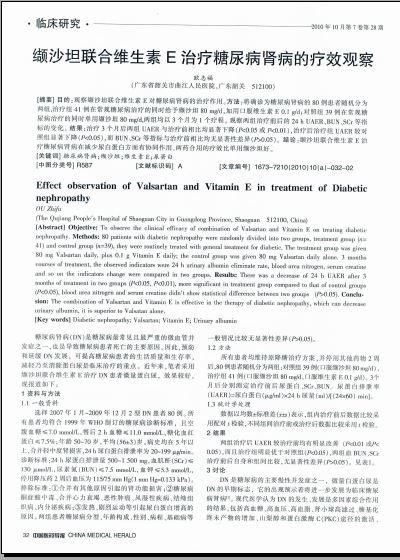缬沙坦联合维生素E治疗糖尿病肾病的疗效观察
 |
| 第1页 |
参见附件(1322KB,2页)。
[摘要] 目的:观察缬沙坦联合维生素E对糖尿病肾病的治疗作用。方法:将确诊为糖尿病肾病的80例患者随机分为两组,治疗组41例在常规糖尿病治疗的同时给予缬沙坦80 mg/d,加用口服维生素E 0.1 g/d;对照组39例在常规糖尿病治疗的同时单用缬沙坦80 mg/d,两组均以3个月为1个疗程。观察两组治疗前后的24 h UAER、BUN、SCr等指标的变化。结果:治疗3个月后两组UAER与治疗前相比均显著下降(P<0.05或P<0.01),治疗后治疗组UAER较对照组显著下降(P<0.05),而BUN、SCr等指标与治疗前相比均无显著性差异(P>0.05)。结论:缬沙坦联合维生素E治疗糖尿病肾病在减少尿白蛋白方面有协同作用,两药合用的疗效比单用缬沙坦好。
[关键词] 糖尿病肾病;缬沙坦;维生素E;尿蛋白
[中图分类号] R587[文献标识码]A [文章编号]1673-7210(2010)10(a)-032-02
Effect observation of Valsartan and Vitamin E in treatment of Diabetic nephropathy
OU Zhifu
(The Qujiang People′s Hospital of Shaoguan City in Guangdong Province, Shaoguan 512100, China)
[Abstract] Objective: To observe the clinical efficacy of combination of Valsartan and Vitamin E on treating diabetic nephropathy. Methods: 80 patients with diabetic nephropathy were randomly divided into two groups, treatment group (n=41) and control group (n=39), they were routinely treated with general treatment for diabetic. The treatment group was given 80 mg Valsartan daily, plus 0.1 g Vitamin E daily; the control group was given 80 mg Valsartan daily alone. 3 months courses of treatment, the observed indicators were 24 h urinary albumin eliminate rate, blood urea nitrogen, serum creatine and so on the indicators change were compared in two groups. Results: There was a decrease of 24 h UAER after 3 months of treatment in two groups (P<0.05, P<0.01), more significant in treatment group compared to that of control groups (P<0.05), blood urea nitrogen and serum creatine didn′t show statistical difference between two groups (P>0.05). Conclusion: The combination of Valsartan and Vitamin E is effective in the therapy of diabetic nephropathy, which can decrease urinary albumin, it is superior to Valsatan alone.
[Key words] Diabetic nephropathy; Valsartan; Vitamin E; Urinary albumin
糖尿病肾病(DN)是糖尿病最常见且最严重的微血管并发症之一,也是导致糖尿病患者死亡的主要原因。因此,预防和延缓DN发展,可提高糖尿病患者的生活质量和生存率,减轻乃至消除蛋白尿是临床治疗的重点。近年来,笔者采用缬沙坦联合维生素E治疗DN患者微量蛋白尿,效果较好,现报道如下:
1 资料与方法
1.1 一般资料
选择2007年1月~2009年12月2型DN患者80例。所有患者均符合1999年WHO制订的糖尿病诊断标准,且空腹血糖≤7.0 mmol/L,餐后2 h血糖≤11.0 mmol/L,糖化血红蛋白≤7.5%;年龄50~70岁,平均(56±3)岁。病史均在5年以上,合并轻中度肾损害,24 h尿白蛋白排泄率为20~199 μg/min。诊断标准:24 h尿蛋白排泄量500~1 500 mg,血肌酐(SCr)≤130 μmol/L,尿素氮(BUN)≤7.5 mmol/L,血钾≤5.3 mmol/L,停用降压药2周后血压为115/75 mm Hg(1 mm Hg=0.133 kPa)。排除标准:①合并有其他原因引起的肾功能损害;②糖尿病酮症酸中毒、合并心力衰竭、恶性肿瘤、风湿性疾病、结缔组织病、内分泌疾病;③发热、剧烈运动等引起尿白蛋白增高的原因。两组患者糖尿病分型、年龄构成、性别、病程、基础病等一般情况比较无显著性差异(P>0.05)。
1.2 方法
所有患者均维持原降糖治疗方案,并停用其他药物2周后,80例患者随机分为两组:对照组39例(口服缬沙坦80 mg/d),治疗组41例(口服缬沙坦80 mg/d,口服维生素E 0.1 g/d)。3个月后分别测定治疗前后尿蛋白、SCr、BUN。尿蛋白排泄率(UAER)=尿白蛋白(μg/ml)×24 h尿量(ml)/[(24×60) min]。
1.3 统计学处理
数据以均数±标准差(x±s)表示,组内治疗前后数据比较采用配对t检验,不同组间治疗前或治疗后数据比较采用t检验。
2 结果
两组治疗后UAER较治疗前均有明显改善(P<0 ......
您现在查看是摘要介绍页,详见PDF附件(1322KB,2页)。